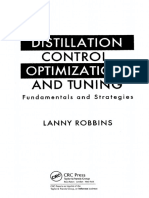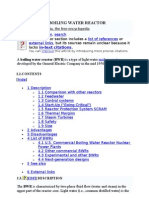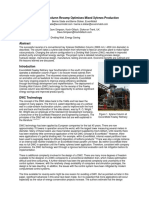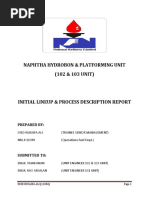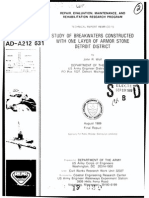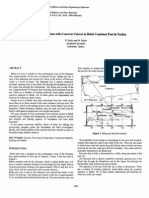0 ratings0% found this document useful (0 votes)
311 viewsComponents of The Glycol Circulating System
The glycol circulating system consists of several main components:
1) A reciprocating pump drives the circulation of glycol and can be electric, gas, or glycol powered.
2) Heat exchangers allow for heating and cooling of glycol to minimize energy use.
3) Filters remove particulate and dissolved impurities from the glycol to prevent foaming.
4) A surge drum absorbs fluctuations in circulation flow between vessels and thermal expansion.
Uploaded by
dndudcCopyright
© © All Rights Reserved
Available Formats
Download as PDF, TXT or read online on Scribd
0 ratings0% found this document useful (0 votes)
311 viewsComponents of The Glycol Circulating System
The glycol circulating system consists of several main components:
1) A reciprocating pump drives the circulation of glycol and can be electric, gas, or glycol powered.
2) Heat exchangers allow for heating and cooling of glycol to minimize energy use.
3) Filters remove particulate and dissolved impurities from the glycol to prevent foaming.
4) A surge drum absorbs fluctuations in circulation flow between vessels and thermal expansion.
Uploaded by
dndudcCopyright
© © All Rights Reserved
Available Formats
Download as PDF, TXT or read online on Scribd
You are on page 1/ 3
Components of the Glycol Circulating System
The Glycol Circulating Pump
The circulation of glycol is done with a reciprocating pump. The pump is driven by an electric
motor, natural gas pressure, or the high-pressure, rich glycol returning from the contactor.
Electric-motor-driven pumps are usually employed in central dehydration facilities where
electric power is available. In field installations, a natural gas powered pump or a glycol powered
pump can be used. In the latter case, the high pressure, rich glycol, with the assistance of a small
amount of high pressure gas, flowing out of the contactor, is used to provide the power needed to
stroke the pump. The required pump rate in field dehydration units is usually small, and,
therefore, a single plunger pump is normally used. When the gas rate is large, duplex or triplex
pumps are used.
The main problems with glycol pumps are leaks through the packing around the plunger, as well
as sticking check valves. If the packing gland nut is tightened too much, the rod may get scored.
Usually, a small pan is placed under the pump or the plunger portion of the pump to contain the
leaked glycol.
Heat Exchange
Because glycol must be relatively cool when entering the absorber and is heated to near its
boiling temperature for regeneration, the liquid is continuously subjected to heating and cooling.
To minimize the use of energy in the regeneration of the glycol at high temperature, several heat-
exchange opportunities are built into most glycol circulating systems. Heat exchange usually
occurs in certain locations: coil in the top of the reboiler still; coil in the surge tank or separate
heat exchanger between rich and lean glycol; and pipe-in-pipe heat exchanger ahead of the
glycol absorber or a coil in the top of the absorber.
In some cases, an additional heat exchanger is necessary to exchange heat with air, to cool the
lean glycol ahead of the contactor. It is necessary to limit the temperature of the lean glycol to
only a few degrees above the temperature of the gas to increase the absorption of the water by
glycol. Too high a glycol temperature reduces the transfer of water from the gas to the glycol,
and the water dewpoint may not be met. This is frequently the problem in summer operations, in
which the gas is dehydrated after compression. On hot days, the glycol, as well as the gas, might
be above normal temperatures. Usually, by exchanging heat with the dried gas through a double
pipe exchanger or through a coil in the top of the contactor in small units, the temperature of the
glycol is adjusted to a few degrees above the temperature of the gas leaving the contactor.
Filters
It is very important to maintain the glycol in as clean a condition as possible. For this reason,
filters are always incorporated in a glycol circulating system. These filters are usually particulate
filters and carbon filters.
The particulate filters are intended to remove solids down to a 5-m diameter. Solids can occur
from corrosion in the glycol system. Carbon filters are designed to remove dissolved impurities,
such as compressor oil or condensate from the glycol solution. Particulate filters are usually
installed on the rich glycol side and are in operation all the time. Carbon filters may be bypassed
most of the time, if there is no dissolved hydrocarbon in the glycol. Impurities in the glycol
solution might promote foaming in the contactor or still.
Surge Drum
Because the glycol that is being circulated might not always flow evenly at the same rate
throughout the system, a vessel, the surge drum, is required that can handle any surges in the
circulation rate. The reboiler always contains a liquid level above the fire tube. Glycol levels in
the absorber or flash tank are essentially constant but might fluctuate slightly. Thus, there is a
need for a vessel that can absorb slight temporary differences in circulation flow between the
various vessels, as well as the thermal expansion of the glycol upon startup.
The surge drum is usually located below the reboiler, or at least at a level below the glycol in the
reboiler. The glycol level in the surge drum is important because in some instances there is a heat
exchange coil in the surge drum, as explained earlier. The level of glycol in the surge drum
should be about at the two-thirds full level. The liquid level in the surge drum is an item that is
usually checked by the operators. If the level is lower than normal, this might be the first
indication of trouble, such as high glycol losses with the treated gas, losses with the vapors
leaving the reboiler still, holdup in one of the vessels, or leaks in the piping.
Strainer
A strainer should always be installed upstream of the suction of the glycol pump. The glycol
strainer ensures that no solid particles enter into the glycol pump. The main problem with solids
entering the pump is that they might lodge in the suction or discharge valves and prevent the
pump from pumping at maximum efficiency.
Glycol Flash Tank
Whenever gas is in contact with a liquid at elevated pressures, such as natural gas and glycol in
the contactor, some of the gas physically dissolves in the liquid. The greater the contacting
pressure, the more gas dissolves in the liquid. Thus, some natural gas dissolves in the glycol in
the absorber in addition to the water vapor. When the glycol reaches the flash tank, its
temperature has been raised through the coil in the reboiler still, and the pressure in the flash tank
is at a much lower level, generally between 15 to 50 psig, than the pressure in the contactor. In
light of these changed conditions of pressure and temperature between the absorber and flash
tank, most of the dissolved gases evolve from the glycol in the flash tank.
On larger systems, the glycol flash tank can be designed as a three-phase separator to help
remove any condensate that becomes entrained in the glycol. This bulk separator increases the
operating life of the downstream filters.
Glycol Piping
All the vessels through which glycol is circulated are interconnected with steel piping. Glycol is
a substance that is prone to leak through threaded connections in piping, as well as through the
packing on glycol pump plungers. For this reason, some operators prefer welded piping rather
than threaded piping for the glycol system. There are, however, many threaded glycol systems
that have provided leak-free service.
Because the pump rate is usually small, the piping in most field installations is of small diameter.
It is important to check the piping for leaks and to repair them as soon as possible.
You might also like
- Critical Path Method (CPM) in Project ManagementNo ratings yetCritical Path Method (CPM) in Project Management11 pages
- McCabe-Thiele Distillation Column Design For A Methanol-Propanol SystemNo ratings yetMcCabe-Thiele Distillation Column Design For A Methanol-Propanol System12 pages
- Functional Specification Export Gas Compressor PDFNo ratings yetFunctional Specification Export Gas Compressor PDF7 pages
- Introduction To Heat Exchangers: Transport Phenomenon (CH 306)No ratings yetIntroduction To Heat Exchangers: Transport Phenomenon (CH 306)101 pages
- 37 - 4 - Washington DC - 08-92 - 1855 PDFNo ratings yet37 - 4 - Washington DC - 08-92 - 1855 PDF9 pages
- Condenser Hot Vapor Bypass Control: PetrocontrolNo ratings yetCondenser Hot Vapor Bypass Control: Petrocontrol6 pages
- AX5 Vaporizer Electric Water Bath Type LPG VaporizerNo ratings yetAX5 Vaporizer Electric Water Bath Type LPG Vaporizer2 pages
- Sump With Weir and Themosyphone Reboiler Modeling ApproachNo ratings yetSump With Weir and Themosyphone Reboiler Modeling Approach7 pages
- Properly Employ Overhead Condensers For Vacuum ColumnsNo ratings yetProperly Employ Overhead Condensers For Vacuum Columns8 pages
- Graham - Lessons From The Field - Ejector SystemNo ratings yetGraham - Lessons From The Field - Ejector System5 pages
- Full download (Ebook) Power Plant Engineering by Farshid Zabihian ISBN 9781498707121, 1498707122 pdf docx100% (5)Full download (Ebook) Power Plant Engineering by Farshid Zabihian ISBN 9781498707121, 1498707122 pdf docx71 pages
- Troubleshooting A C3 Splitter Tower Part 1 EvaluationNo ratings yetTroubleshooting A C3 Splitter Tower Part 1 Evaluation6 pages
- Room Temperature Synthesis of Copper Oxide Nanoparticles Morphological Evaluation and Their Catalytic Applications For Degradation of Dyes and C-N Bond Formation Reaction PDFNo ratings yetRoom Temperature Synthesis of Copper Oxide Nanoparticles Morphological Evaluation and Their Catalytic Applications For Degradation of Dyes and C-N Bond Formation Reaction PDF11 pages
- Failure of Heat Exchanger in Sulphur Recovery Unit PDFNo ratings yetFailure of Heat Exchanger in Sulphur Recovery Unit PDF8 pages
- Urmes-2019-Kinetic-study-of-the-selective-hydrogenation of Acetylene100% (1)Urmes-2019-Kinetic-study-of-the-selective-hydrogenation of Acetylene13 pages
- Dynamic Heat Transfer Analysis of Liquefied Natural Gas Ambient Air Vaporizer Under Frost ConditionsNo ratings yetDynamic Heat Transfer Analysis of Liquefied Natural Gas Ambient Air Vaporizer Under Frost Conditions9 pages
- A Systemic Optimization Approach For The Design of Natural Gas Dehydration PlantNo ratings yetA Systemic Optimization Approach For The Design of Natural Gas Dehydration Plant9 pages
- Air-Cooled Heat Exchangers: Design PrinciplesNo ratings yetAir-Cooled Heat Exchangers: Design Principles29 pages
- Fired Heaters - Fired Capital Equipment Key Plant ComponentsNo ratings yetFired Heaters - Fired Capital Equipment Key Plant Components4 pages
- 1.1.7Plug flow Reactor design: V Volume of reactor F X τ C A (subscript) rNo ratings yet1.1.7Plug flow Reactor design: V Volume of reactor F X τ C A (subscript) r3 pages
- Effect of Condenser Subcooling of The Performance of Vapor CompreNo ratings yetEffect of Condenser Subcooling of The Performance of Vapor Compre11 pages
- Cooling Tower: Presented by Anis Abbas ME-1No ratings yetCooling Tower: Presented by Anis Abbas ME-136 pages
- HowtodesignChimneyTrays EngineeringPractice JAN2023No ratings yetHowtodesignChimneyTrays EngineeringPractice JAN202310 pages
- Valve Sizing Selection 1231875721684103 3No ratings yetValve Sizing Selection 1231875721684103 315 pages
- Troubleshooting A C3 Splitter Tower Part2 Root Cause and SolutionNo ratings yetTroubleshooting A C3 Splitter Tower Part2 Root Cause and Solution7 pages
- Definition & Types of Reboilers - A. Thermosiphon - : Reboiler CircuitsNo ratings yetDefinition & Types of Reboilers - A. Thermosiphon - : Reboiler Circuits2 pages
- Energy Perfomance Assessment For Equipmenet and UtilityNo ratings yetEnergy Perfomance Assessment For Equipmenet and Utility24 pages
- Two-Phase Condensation Heat Transfer Models100% (1)Two-Phase Condensation Heat Transfer Models14 pages
- Steam Air Ejector Performance and Its Dimensional ParametersNo ratings yetSteam Air Ejector Performance and Its Dimensional Parameters296 pages
- Initial Reactor Thermal Hydraulic Design: ActivityNo ratings yetInitial Reactor Thermal Hydraulic Design: Activity4 pages
- HP Simplify Your Thermal Efficiency Calculation PDFNo ratings yetHP Simplify Your Thermal Efficiency Calculation PDF9 pages
- PROCESS SAFETY&Mdash 1 - Gas Conditioning Failures Show Need For Design Scrutiny - Oil & Gas JournalNo ratings yetPROCESS SAFETY&Mdash 1 - Gas Conditioning Failures Show Need For Design Scrutiny - Oil & Gas Journal6 pages
- Design and Control of Distillation Systems for Separating AzeotropesFrom EverandDesign and Control of Distillation Systems for Separating AzeotropesNo ratings yet
- Wireline Log Quality Control Reference Manual83% (6)Wireline Log Quality Control Reference Manual280 pages
- Construction Presentation - Container Terminal PDF100% (1)Construction Presentation - Container Terminal PDF60 pages
- Environmental Practice - Onshore Pipeline PDFNo ratings yetEnvironmental Practice - Onshore Pipeline PDF132 pages
- 5 - Technical Specifications For Sand & Murrum Filling Works - Pile Foundation For Tanks - ParadeepNo ratings yet5 - Technical Specifications For Sand & Murrum Filling Works - Pile Foundation For Tanks - Paradeep21 pages
- Behaviour of Reinforced Earth Behind Quay Walls PDFNo ratings yetBehaviour of Reinforced Earth Behind Quay Walls PDF9 pages
- Certification Process of Storage Tank PDFNo ratings yetCertification Process of Storage Tank PDF32 pages
- Study of Breakwaters Constructed With One Layer of Armor Stone PDFNo ratings yetStudy of Breakwaters Constructed With One Layer of Armor Stone PDF58 pages
- H - Quay Walls Restoriation Method Statement100% (1)H - Quay Walls Restoriation Method Statement34 pages
- Quay Construction With Concrete Caisson PDFNo ratings yetQuay Construction With Concrete Caisson PDF5 pages
- Study of Reflection of New Low-Reflectivity Quay Wall Caisson PDFNo ratings yetStudy of Reflection of New Low-Reflectivity Quay Wall Caisson PDF11 pages
- Functional Specification Diesel Fuel System PDF100% (1)Functional Specification Diesel Fuel System PDF5 pages
- Xps Studies For Nacl Deposited On The Ni (Ll1) SurfaceNo ratings yetXps Studies For Nacl Deposited On The Ni (Ll1) Surface10 pages
- Crack Control For Concrete Brick and Masonry Veneer (NCMA TEK 10-4)No ratings yetCrack Control For Concrete Brick and Masonry Veneer (NCMA TEK 10-4)4 pages
- SANS5841 - Aggregate Crushing Value of Coarse AggregatesNo ratings yetSANS5841 - Aggregate Crushing Value of Coarse Aggregates8 pages
- Intel® MPI Library For Windows OS: Developer GuideNo ratings yetIntel® MPI Library For Windows OS: Developer Guide32 pages
- 8 Reasons To Turn Down The Transmit Power of YourNo ratings yet8 Reasons To Turn Down The Transmit Power of Your3 pages
- Valtek Handwheels and Limit Stops (Flow Serve)No ratings yetValtek Handwheels and Limit Stops (Flow Serve)12 pages
- Code of Top - Qfunc Module:: Part 1 - Making The Function LN (N) /TNo ratings yetCode of Top - Qfunc Module:: Part 1 - Making The Function LN (N) /T22 pages
- 2271 2019 BWSC Regulations Release Version 2No ratings yet2271 2019 BWSC Regulations Release Version 263 pages
- ICT Project Management Status Checklist.No ratings yetICT Project Management Status Checklist.3 pages
- 28 Aug 1995 Male OBC No: Communication Address GATE Exam DetailsNo ratings yet28 Aug 1995 Male OBC No: Communication Address GATE Exam Details1 page
- Efficient Algorithm Comparison To Solve Sudoku PuzzleNo ratings yetEfficient Algorithm Comparison To Solve Sudoku Puzzle5 pages

















